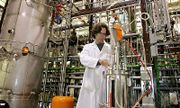The first such substance approved for therapeutic use was recombinant human insulin (rHI, trade name Humulin), which was developed by Genentech and marketed by Eli Lilly and Company in 1982.

The large majority of biopharmaceutical products are pharmaceuticals that are derived from life forms. Small molecule drugs are not typically regarded as biopharmaceutical in nature by the industry. However members of the press and the business and financial community often extend the definition to include pharmaceuticals not created through biotechnology. That is, the term has become an oft-used buzzword for a variety of different companies producing new, apparently high-tech pharmaceutical products.
When a biopharmaceutical is developed, the company will typically apply for a patent, which is a grant for exclusive manufacturing rights. This is the primary means by which the developer of the drug can recover the investment cost for development of the biopharmaceutical. The patent laws in the United States and Europe differ somewhat on the requirements for a patent, with the European requirements are perceived as more difficult to satisfy. The total number of patents granted for biopharmaceuticals has risen significantly since the 1970s. In 1978 the total patents granted was 30. This had climbed to 15,600 in 1995, and by 2001 there were 34,527 patent applications.[2]
Within the United States, the Food and Drug Administration (FDA) exerts strict control over the commercial distribution of a pharmaceutical product, including biopharmaceuticals. Approval can require several years of clinical trials, including trials with human volunteers. Even after the drug is released, it will still be monitored for performance and safety risks.
The manufacture of the drug must satisfy the "current Good Manufacturing Practices" regulations of the FDA. They are typically manufactured in a clean room environment with set standards for the amount of airborne particles.
Contents |
Classification of biopharmaceuticals
- Blood factors (Factor VIII and Factor IX)
- Thrombolytic agents (tissue plasminogen activator)
- Hormones (Insulin, growth hormone, gonadotrophins)
- Haematopoietic growth factors (Erythropoietin, colony stimulating factors)
- Interferons (Interferons-α, -β, -γ)
- Interleukin-based products (Interleukin-2)
- Vaccines (Hepatitis B surface antigen)
- Monoclonal antibodies (Various)
- Additional products (tumour necrosis factor, therapeutic enzymes)
Uses
- Erythropoietin - Treatment of anaemia
- Interferon-α - Treatment of leukaemia
Interferon-β - Treatment of multiple sclerosis
Monoclonal antibody - Treatment of rheumatoid arthritis
Colony stimulating factors - Treatment of neutropenia
Glucocerebrosidase - Treatment of Gaucher's disease
Large scale production
Biopharmaceuticals may be produced from microbial cells (e.g. recombinant E. coli), mammalian cell lines (see cell culture) and plant cell cultures (see plant tissue culture) in bioreactors of various configurations.
Important issues of concern are cost of production (a low volume, high purity product is desirable) and microbial contamination (by bacteria, viruses, mycoplasma, etc). Alternative platforms of production which are being tested include whole plants (plant-made pharmaceuticals).
Transgenics
A potentially controversial method of producing biopharmaceuticals involves transgenic organisms, particularly plants and animals that have been genetically modified to produce drugs. The production of these organisms represents a significant risk on the part of the investor, both in terms of the risk of failure to produce the required organism, and in the risk of non-acceptance by government bodies due to the perceived risks and from ethical issues. Biopharmaceutical crops also represent a risk of cross-contamination with non-engineered crops, or crops engineered for non-medical purposes.
One potential approach to this technology is the creation of a transgenic mammal that can produce the biopharmaceutical in its milk (or blood or urine). Once an animal is produced, typically using the pronuclear microinjection method, it becomes efficacious to use cloning technology to create additional offspring that carry the favorable modified genome. [3] The first such drug manufactured from the milk of a genetically-modified goat was ATryn®, but marketing permission was blocked by the European Medicines Agency in February 2006.[4] This decision was reversed in June 2006 and approval was given August 2006. [5]
See also
Reference
- ^ Walsh, Gary. Biopharmaceuticals: Biochemistry and Biotechnology, Second Edition. John Wiley & Sons Ltd. ISBN 0-470-84326-8 (ppc), ISBN 0-470-84327-6 (pbk).
- ^ Luke Foster. Patenting in the Biopharmaceutical Industry—comparing the US with Europe. Retrieved on 2006-06-23.
- ^ Alan Dove (2000). "Milking the Genome for Profit". Nature Biotechnology 18: 1045-1048.
- ^ Phillip B. C. Jones. European Regulators Curdle Plans for Goat Milk Human Antithrombin. Retrieved on 2006-06-23.
- ^ Go-ahead for 'pharmed' goat drug. Retrieved on 2006-10-25.




 216.73.216.81
216.73.216.81 User Stats:
User Stats:
 Today: 0
Today: 0 Yesterday: 0
Yesterday: 0 This Month: 0
This Month: 0 This Year: 0
This Year: 0 Total Users: 117
Total Users: 117 New Members:
New Members:
 216.73.xxx.xx
216.73.xxx.xx
 Server Time:
Server Time: